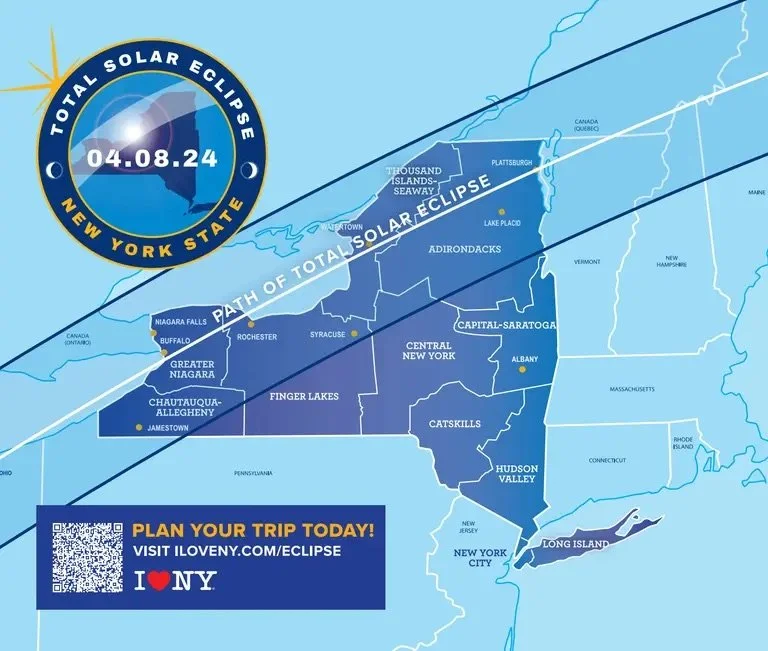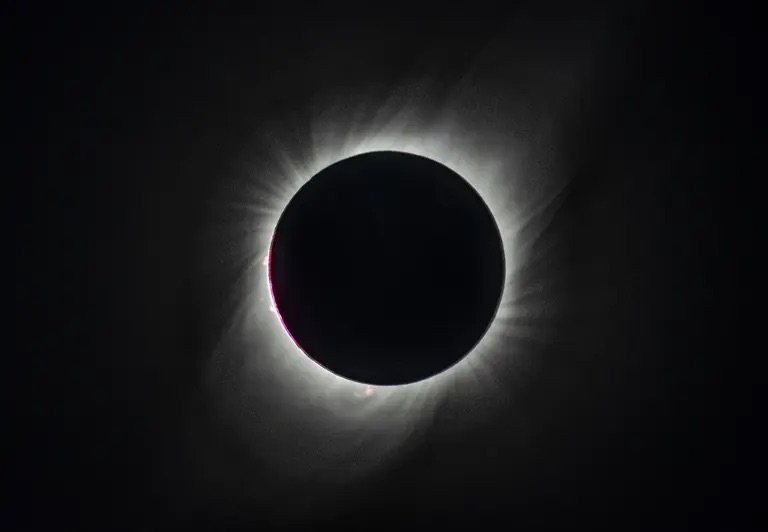Poster created through an I LOVE NY partnership with acclaimed artist and professional astronomer Dr. Tyler Nordgren. Courtesy of I LOVE NY
New York is going all out for its first total solar eclipse in 99 years. Gov. Kathy Hochul on Wednesday revealed the state’s plans for the April 8 total eclipse, when the moon will pass between the sun and earth, completely blocking the face of the sun and turning day to night for up to four minutes. Five regions in New York will experience the path of totality, including the Adirondacks, Greater Niagra, Chautauqua-Allegheny, Thousand Islands-Seaway, and the Finger Lakes. Other parts of the state outside of the path, like New York City and Long Island, will see a partial eclipse.
For over a year, nearly two dozen state agencies have been working to ensure that the once-in-a-lifetime event is a truly memorable experience by launching a multi-platform campaign that includes a special eclipse website with a guide to a variety of eclipse-related attractions throughout the state, digital displays in high-traffic areas, and more.
“Whether you live in New York or are visiting to witness this generational spectacle, ensuring everyone can take in this year’s eclipse safely is our top priority. I encourage everyone to keep safety in mind so that all can savor this experience and make memories to last a lifetime. Come for the eclipse, but stay for New York and enjoy all our great state has to offer,” Hochul said.
Image courtesy of NASA/Goddard/Rebecca Roth on Flickr
Image courtesy of I LOVE NY
On the afternoon of April 8, the western and northern parts of New York will experience a total eclipse. The 124-mile path of totality will enter the southwestern part of the state at around 3:15 p.m. and will leave right before 3:30 p.m. The cities and towns located within this path include Jamestown, Buffalo, Rochester, Syracuse, Watertown, Old Forge, Lake Placid, and Plattsburgh.
Other areas of the state that lie outside the path will still be able to experience the cosmic event. New York City will see 89 percent coverage, Long Island will see 88 percent coverage, and the Capital Region will have 96 percent coverage. The entire event will last approximately two and a half hours, starting at the time it is first obstructed to the final moments when the moon’s shadow is cast.
The next cross-country solar eclipse in North America won’t happen for another 20 years.
Total Solar Eclipse, July 2, 2019. Image courtesy of NASA/Goddard/Rebecca Roth on Flickr
Launched by the state’s tourism agency, I LOVE NY, the “Come for the Eclipse, Stay for New York” campaign seeks to emphasize New York as the place to be to witness the event. The campaign’s special eclipse website will highlight the best viewing locations throughout the state to view the eclipse in totality, instruct New Yorkers on how to view the event safely, deploy digital displays in high-traffic areas like Manhattan’s Moynihan Train Hall, and more.
The website also includes information and resources for educators, families and kids, as well as photos and answers to frequently asked questions about solar eclipses.
In the fall, Hochul announced the state’s Parks department will collaborate with the National Aeronautics and Space Administration (NASA) on programs and events throughout the city of Niagara Falls.
“We have been planning for this event for several years and in our wildest dreams couldn’t have imagined being able to work with NASA to provide this incredible experience,” Erik Kulleseid, commissioner of New York State Parks, said. “We know that people will be flocking to the city and Park to take part in all of the events leading up to the big moment.”
New York has big plans for the state’s first total solar eclipse in 99 years
January 11, 2024
Cover image courtesy of NASA/Goddard/Rebecca Roth on Flickr





